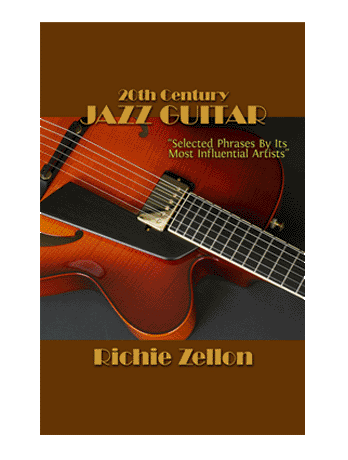Below is the first of a 4-part video tutorial on “How to Expand Your Improvisational Vocabulary” using the Jazz Guitarist Signature Series. Part 1 is an introduction to the series and explains its goal and purpose. Part 2 is all about “transcribing” solos and also examines a lesser known concept also used in learning new vocabulary. Part 3 covers various techniques and resources to incorporate your transcribed phrases when soloing over a jazz standard. Finally, Part 4 suggests how to organize a 1 year practice routine to expand your vocabulary.
It is recommended that you watch the videos in order as concepts explained in the previous video(s) are frequently alluded to.
Part 1: What is the Jazz Guitarists Signature Series?
To PART 2: Transcribing versus Writing
The following is a transcription of the video: “How To Use The Jazz Guitarists Signature Series To Expand Your Improvisational Vocabulary” PART 1 …
PART 1: Intro
Hi, I’m Richie Zellon and I’d like to welcome you to the Jazz Guitarists Signature Series. This is an ongoing video series featuring transcriptions of short improvised phrases by some of the most influential players in the history of jazz guitar. Don’t let the fact that they are short in duration lead you to think that there is not much to learn here. These melodic snippets contain the essence of this musical idiom we call jazz. Furthermore, because they are short they are much easier to memorize, transpose, and alter for all practical purposes. I have broken this tutorial down into 4 parts in order to make it easier to digest. Be sure to watch it in order to understand any previously mentioned concepts I might refer to.
The phrases you will encounter in this series are played over frequently recurring harmonic progressions that appear in the jazz standards repertoire. Of these, the II-V-I is one of the most common ones you’ll encounter, as you are probably aware. Jazz musicians spend their entire lives learning new interesting ways to improvise over these recurring chord changes. The average professional jazz musician spends several hours a day studying and practicing new vocabulary. Now, whether you are a professional guitarist or someone who plays in their spare time, you might not be able to afford to spend that amount of time, especially in this day and age. This is where digesting a new short phrase every week becomes not only practical but very convenient. In this video I will talk about how to utilize the material from this series to expand your improvisational vocabulary.
I originally put together this series of short transcriptions for my students at Miami Jazz Guitar and various universities I have taught at. It has served the purpose of supplementing their jazz guitar studies with living examples of how master improvisers have applied various improvisational techniques throughout the evolution of this genre. I have decided to share it with the online jazz guitar community as a tribute to all those great guitarists who have carried the torch as well as a means to expand my reach as a music educator.
The development of new vocabulary is an endless quest for the improvising musician. Jazz is a language; and as is the case with any language, we must first study its grammar if we intend to express ourselves clearly, correctly and without limitations. That said, I would like to put forth a disclaimer before continuing. So please listen carefully to what I am going to say next:
By learning several of these transcriptions alone, without having an understanding of what is going on both harmonically and melodically in any given phrase, you are not going to learn how to improvise! This is akin to learning how to pronounce a phrase in mandarin Chinese without knowing the significance of what you are actually saying. Furthermore, no matter how good your pronunciation is, you will not even be able to use the phrase in the context of a conversation if you don’t know what you are saying. So, even if you are a technically proficient guitarist, if you have no understanding of basic theory and jazz harmony …STOP! First become proficient at playing all your scales and chords in all keys and varied fingerings throughout the fretboard. In addition, make sure you understand the relationship between the notes in a scale and the chord you are using it over. For example, know when you are playing a 3rd or a 7th or a passing tone. If you are lacking in these resources, by all means still watch the videos, download the notation and the mp3s, and meanwhile let your ear become familiar with the phrases until the time comes when you feel you are ready to start playing them. Some of you are probably advanced enough to study on your own while others will need the guidance of an experienced teacher. Please contact me if I can be of assistance. That concludes my disclaimer.
For those of you who are still with me I’d like to proceed and share various tips which will help you apply this series to expand your improvisational vocabulary. So brew some java, and get comfortable with paper and pencil as we are going to cover plenty of material.
